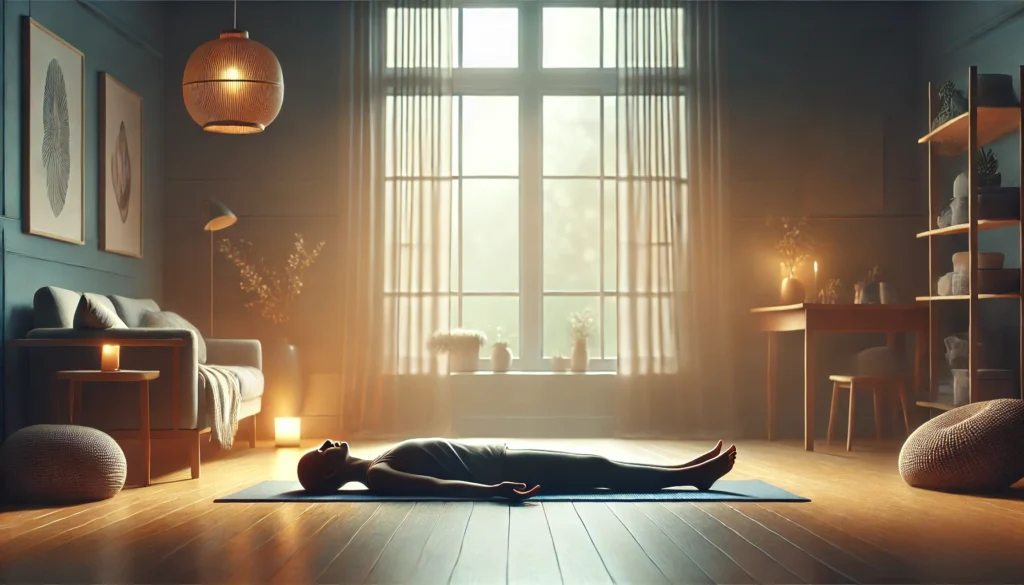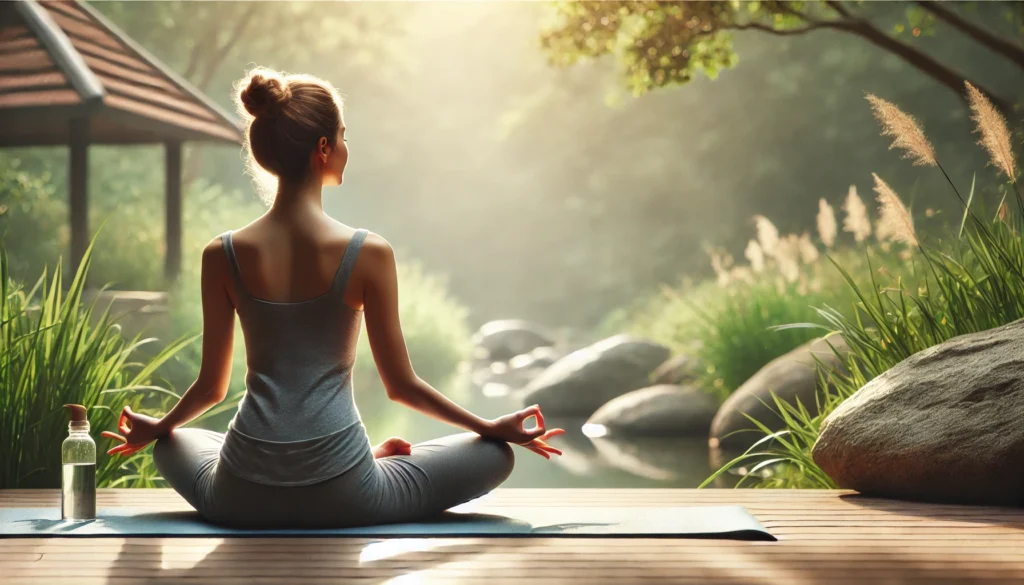In the realm of holistic health practices, yoga stands out as a timeless, transformative discipline that not only enhances physical strength and flexibility but also cultivates mental serenity and emotional equilibrium. Particularly in our fast-paced, modern world, the practice of yoga can serve as a sanctuary for those seeking respite from the relentless pressures of daily life. This article delves into beginner-friendly yoga poses specifically designed to alleviate stress, offering a harmonious blend of scientific insights, practical advice, and historical context.
You may also like: Natural Supplements for Effective Anxiety Relief

The Science Behind Yoga and Stress Relief
Yoga and the Autonomic Nervous System
The relationship between yoga and stress reduction is well-documented in scientific literature. At the heart of this connection lies the autonomic nervous system, which governs our body’s stress response. The autonomic nervous system is divided into the sympathetic and parasympathetic systems. Yoga, through its emphasis on breath control, meditation, and physical postures, activates the parasympathetic nervous system, often referred to as the “rest and digest” system. This activation not only mitigates the physiological stress response but also fosters a state of relaxation and tranquility, countering the “fight or flight” impulse.
Hormonal Modulation and Stress Reduction
Moreover, yoga has been shown to modulate the production of stress hormones such as cortisol. Cortisol is often dubbed the “stress hormone,” and its chronic elevation can lead to numerous health issues, including anxiety and depression. Regular practice of yoga leads to a reduction in cortisol levels, thereby diminishing the negative effects of chronic stress on the body and mind. Studies have shown that yoga practitioners often exhibit lower baseline levels of cortisol, suggesting a long-term benefit of consistent practice.
Yoga’s Influence on Neurotransmitters
Additionally, yoga’s impact on neurotransmitters like gamma-aminobutyric acid (GABA) enhances mood and reduces anxiety, further underscoring its therapeutic potential. GABA is a neurotransmitter that inhibits nerve transmission in the brain, calming nervous activity. Increased levels of GABA in yoga practitioners have been linked to improved mood and reduced symptoms of anxiety. This neurochemical change highlights yoga’s potential as a complementary treatment for mental health conditions.

Historical Context: Yoga’s Evolution as a Stress-Relief Modality
Ancient Origins of Yoga
Yoga’s roots trace back over 5,000 years to ancient India, where it was conceived as a spiritual and ascetic discipline aimed at achieving enlightenment. Initially, yoga was deeply intertwined with Hindu philosophy and was practiced by sages and ascetics as a means of spiritual development. The earliest forms of yoga focused on meditation and breath control, emphasizing the mind’s role in spiritual awakening.
Evolution of Yoga Practices
Over millennia, yoga evolved, assimilating diverse philosophies and practices, ultimately emerging as a multifaceted system for promoting holistic well-being. The integration of physical postures into yoga practice is a relatively recent development, gaining prominence in the 19th and 20th centuries. This evolution has allowed yoga to be more accessible and appealing to a broader audience, focusing not only on spiritual enlightenment but also on physical health and stress management.
Yoga’s Global Renaissance in the 20th Century
Notably, the 20th century witnessed a global renaissance of yoga, with its integration into Western wellness paradigms as a potent stress-relief modality. This era saw the emergence of influential yoga teachers who brought the practice to the West, adapting it to suit modern lifestyles. The incorporation of yoga into modern stress management strategies reflects a broader trend toward holistic health practices that emphasize the interconnectedness of mind, body, and spirit. This historical evolution underscores yoga’s enduring relevance and adaptability, as it continues to provide a sanctuary for individuals seeking solace amidst life’s challenges.
Beginner-Friendly Yoga Poses to Alleviate Stress
1. Child’s Pose (Balasana)
Child’s Pose, or Balasana, is a foundational yoga posture renowned for its calming effects. This gentle forward bend encourages deep relaxation by stretching the back, hips, and thighs while fostering a sense of surrender and introspection. To perform Child’s Pose, kneel on the floor, sit back on your heels, and extend your arms forward, resting your forehead on the mat. Breathe deeply, allowing tension to dissipate with each exhalation. This pose can be held for several minutes, allowing the body and mind to truly relax.
2. Cat-Cow Stretch (Marjaryasana-Bitilasana)
The Cat-Cow Stretch is a dynamic, flowing sequence that synchronizes movement with breath, promoting spinal flexibility and stress release. Begin on all fours, aligning your wrists under your shoulders and knees under your hips. Inhale as you arch your back (Cow Pose), lifting your head and tailbone. Exhale as you round your spine (Cat Pose), tucking your chin and tailbone. Repeat this cycle, embracing the rhythmic ebb and flow of breath and motion. This sequence can help relieve tension in the back and neck, areas often affected by stress.
3. Legs-Up-the-Wall Pose (Viparita Karani)
Legs-Up-the-Wall Pose is a restorative inversion that facilitates relaxation by improving circulation and reducing tension in the legs and lower back. To practice this pose, lie on your back with your legs extended vertically against a wall. Position your hips a few inches away from the wall, and rest your arms by your sides. Close your eyes, breathe deeply, and surrender to the soothing effects of gravity. This pose is especially beneficial after a long day of standing or sitting, as it helps drain excess fluid from the legs.
4. Corpse Pose (Savasana)
Often reserved for the conclusion of a yoga session, Corpse Pose is a quintessential relaxation posture that invites total surrender and introspection. Lie flat on your back, arms and legs comfortably extended, palms facing upward. Focus on your breath, allowing thoughts to drift away as you sink into a state of profound relaxation. Savasana offers a unique opportunity to integrate the physical, mental, and emotional benefits of yoga practice. It’s a moment of stillness that encourages mindfulness and presence, essential components of stress relief.

Current Trends and Future Implications
Rising Popularity of Yoga for Stress Relief
In recent years, the popularity of yoga as a stress-relief practice has soared, driven by a growing awareness of its multifaceted benefits and a cultural shift toward holistic wellness. This trend is reflected in the proliferation of yoga studios, online classes, and wellness retreats, which offer diverse opportunities for individuals to explore yoga’s therapeutic potential. More people are recognizing yoga as a valuable tool for managing stress, enhancing mental clarity, and improving overall health.
Technology and Yoga: A New Era
Looking ahead, the integration of technology into yoga practice presents exciting possibilities for personalized, data-driven stress management. Innovations such as virtual reality yoga, wearable biosensors, and AI-driven yoga apps have the potential to enhance the accessibility and effectiveness of yoga as a stress-relief modality, catering to the evolving needs of a digitally connected world. These technologies offer the promise of customized yoga experiences, tailored to individual stress levels and health goals.
The Future of Yoga in a Digital World
As technology continues to evolve, its role in yoga practice is likely to expand, offering new ways to engage with this ancient discipline. Virtual reality yoga can transport practitioners to serene environments, enhancing the meditative aspect of practice. Wearable biosensors can provide real-time feedback on physiological responses, helping individuals optimize their practice for stress reduction. AI-driven apps can offer personalized routines and track progress over time, making yoga more accessible and effective for everyone.
Practical Advice for Incorporating Yoga into Your Stress-Relief Routine
Starting Your Yoga Journey
For those new to yoga, it’s essential to approach the practice with patience and an open mind. Start with short, manageable sessions, gradually increasing the duration and intensity as you become more comfortable. Consistency is key, as regular practice is more beneficial than sporadic, intensive sessions. Begin with basic poses that are easy to perform and gradually progress to more complex sequences as your confidence grows.
Seeking Guidance and Resources
Consider enrolling in a beginner’s yoga class or utilizing online resources to guide your practice. Seek guidance from experienced instructors who can offer personalized feedback and support. Many online platforms offer a wealth of videos and tutorials tailored to beginners, allowing you to practice at your own pace and convenience. The support of a community or instructor can be invaluable in maintaining motivation and ensuring proper technique.
Listening to Your Body
Most importantly, listen to your body, and honor its signals, adapting poses as needed to suit your unique needs and limitations. Yoga is a personal journey, and it’s crucial to respect your body’s capabilities and boundaries. If a pose feels uncomfortable or causes pain, modify it or skip it altogether. Remember, the goal is to reduce stress, not add to it, so prioritize comfort and safety in your practice.
In conclusion, yoga offers a profound, evidence-based approach to stress relief, enriching both mind and body. By embracing beginner-friendly poses and integrating them into your wellness routine, you can cultivate resilience, enhance well-being, and navigate life’s challenges with grace and equanimity. As you embark on this journey, remember that yoga is not merely a physical practice but a holistic path toward balance, harmony, and inner peace. Embrace the process with patience and openness, and allow the transformative power of yoga to unfold in your life.
Further Reading:
Here’s How to Use Yoga for Stress Reduction
Yoga for relaxation: 5 simple, stress-relieving poses
How Yoga Can Help Reduce Stress
Important Note: The information contained in this article is for general informational purposes only, and should not be construed as health or medical advice, nor is it intended to diagnose, prevent, treat, or cure any disease or health condition. Before embarking on any diet, fitness regimen, or program of nutritional supplementation, it is advisable to consult your healthcare professional in order to determine its safety and probable efficacy in terms of your individual state of health.
Regarding Nutritional Supplements Or Other Non-Prescription Health Products: If any nutritional supplements or other non-prescription health products are mentioned in the foregoing article, any claims or statements made about them have not been evaluated by the U.S. Food and Drug Administration, and such nutritional supplements or other health products are not intended to diagnose, treat, cure, or prevent any disease.


